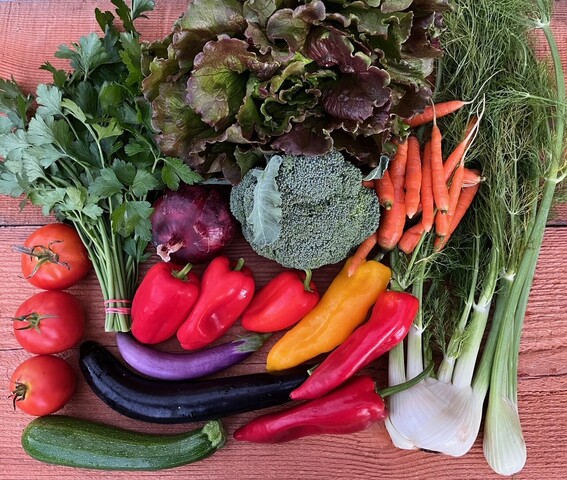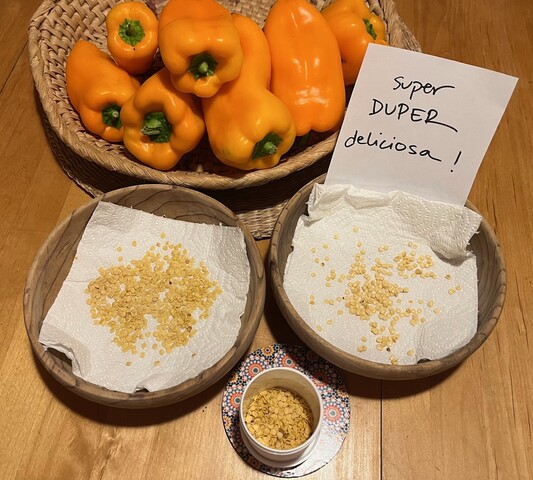In the CSA Share this Week!
- Fennel - here's a yummy frittata recipe that uses your onion, fennel and parsley - a favorite in our house!
- Head Lettuce
- Carrots
- Eggplant
- Red Onion
- Sweet Peppers Galore! (Read all about it below!)
- Tomatoes
- Zucchini
On Rotation:
- Italian Parsley
- Cilantro
- Broccoli
- Romanesco
Our Fall crops are starting to make their debut, kicking off with broccoli, romanesco cauliflower, and a whole host of autumn root crops (turnips, radishes, daikon, and more). Broccoli and romanesco will be on rotation in the coming weeks, and everyone will be seeing some lovely Hakurei and Violet Queen turnips soon.
At this time of year it all adds up to a blazing cornucopia of color: purple eggplant in juxtaposition with wine-red onions, next to traffic-cone-orange carrots, jumbled together with sunset-colored sweet peppers.
And oh, the peppers!! Yes, my favorite food (I have already munched two this morning and it's not even 11 am yet). You're starting to see some orange and yellow varieties in the mix, which are from our outdoor production (versus all of the red peppers you've received to date, which are grown by my mom, Bets, in protected high tunnels where they mature earlier). Our field-grown peppers are hitting their stride big-time this week, and I had to admit to my crew yesterday that my crop planning around peppers was perhaps a tad bit driven by produce favoritism. No, we probably shouldn't have planted four full rows of peppers (maybe two would have been enough?), and no, we probably shouldn't put ten peppers in the CSA tote (although if I was a CSA member I'd LOVE that idea). So what in the world was I thinking last January when I decided to plant a thousand peppers in 2024?
Well, here's the backstory: all these years Bets has been the primary pepper grower at Valley Flora. We're all in charge of different crops, and since the beginning of time, peppers were her purview. This year, at the spry age of 72, she decided to scale back a little and ceded the yellow and orange pepper production to me (she's still growing the reds). It was like winning the lottery, or inheriting the throne, being bequeathed permission to grow peppers at scale. And like a lottery-winner, I guess I went a little wild. We planted out six kinds of yellow and orange sweet peppers (including a couple new trials), plus a bunch of poblanos and a novelty patch of padróns. That should have been plenty but I couldn't leave out reds altogether, so we threw in two red varieties, equals four long rows of peppers, equals a whole lotta pepper picking right now.
Even thought Bets has been the official pepper person all these years, I've always grown a small experimental patch of outdoor peppers, driven by a curiosity about what varieties can perform well for us without greenhouse protection (peppers like heat), and to ensure that I have an endless personal supply of peppers to gorge on come fall. Those outdoor trials led us to discover a sweet pepper named Glow F1, which we fell in love with. It was an orange pepper, somewhere between a bell and an Italian type (Italians, or "cornos," are cone shaped with thinner flesh, great for fresh eating or roasting). Glow had the the thick juicy flesh and incredible sweet flavor of a bell, the problem-free nature of an Italian (less prone to sunburn and rot), and it was also early, consistent, and high-yielding in our coastal climate. In other words, a five star pepper in every way. It soon became a core part of Bets' commercial production in her greenhouses, where it also thrived, and I grew it outside for sheer pepper piggishness come September/October.
And then one terrible day in 2022, Glow was discontinued in the seed catalogues. It's not clear why - the economics and politics of seed production can be very opaque from the outside. It was a hybrid (a variety that is the result of cross-pollinating two different parent varieties), so we were reliant on some far-off seed company to produce the seed for us each year (versus saving our own seed). Crestfallen and frustrated by the fickleness of the hybrid seed industry, I made two decisions last year:
- To trial as many potential Glow replacements as possible in the 2023 growing season, in hopes that we might discover an off-the-shelf replacement, and
- Plant our last one hundred Glow F1 seeds and grow them out in isolation on the farm apart from the rest of our pepper production, thus embarking on our first-ever seed breeding project. The goal? To de-hybridize Glow in hopes of breeding it back to a stable open-pollinated variety with all the awesome pepper traits we loved, and to never have to depend on a seed company again for my favorite pepper! Amen!
Last year's pepper trials taught us mostly what we don't want to grow, but they also revealed a couple of peppers we liked. We're growing some of those at scale this season and they're starting to show up in your tote - a yellow Italian variety called Escamillo and a few smaller orange and yellow varieties called Cornito Arancia, Cornito Giallo and Oranos. They're good - 4 stars! - but not quite the 5 star caliber of Glow.
Meanwhile, we're growing out the F2 generation of Glow from seed saved last year. Breeding back to a stable open pollinated variety can take upwards of seven years and must be done in isolation from other peppers so they don't cross-pollinate. Typically you see a lot of genetic diversity in the F2 generation, when all the traits from the two parent lines of your hybrid start to be visibly expressed. I expected to see a rainbow of diversity in the Glow F2 patch this year - I imagined there would be peppers in every shape, size and color and I'd get to play a fun game of plant selection as I went about saving this next generation of seed. But alas in actuality we're getting surprising uniformity: of our forty F2 plants, all the peppers are orange, and many have the same shape and wonderful flavor of the original hybrid. From a pepper-eating and pepper-farming perspective, it's great news! From a gene-selecting, seed-saving, plant geek perspective, it's kinda boring. But not to complain: having a pile of delicious Glow F2 peppers on my kitchen counter feels like reuniting with a dear old friend who you're happy to discover is still pretty much the same person you knew way back when.
Maybe the best thing about saving pepper seeds is that you get to eat the pepper - and in doing so, justify your sweet pepper gluttony in the name of science. It's become a participatory plant breeding project in our household: my girls each take a whole Glow F2 pepper to school with them every day for lunch and if it's an especially good one, they bring home the pepper top with it's stubble of white seeds and scrape them into the bowl on the kitchen table where the seeds dry on a paper towel before getting transferred into a little jar for next year's planting. Last night one of five Glow peppers I sliced up to put on our salad (yes, five peppers on a single salad - I'm not kidding about the gluttony) blew me away with its flavor and juiciness. I was inspired to pull out a separate bowl from the cupboard, line it with a paper towel, scrape those little seeds into it, and make a special label: "Super Duper Deliciosa."
We'll see what Super Duper Deliciosa does next season - may she be orange and sweet and productive and disease-free (!!!) - but you never know. In the meantime, I will doggedly continue in my plant-breeding pursuit of pepper perfection: twist my arm as I eat another Glow, making it a baker's dozen for the day.
Enjoy this pepper peak, AND if you want more of them we'll be offering bulk sweet peppers by special order to our CSA members very soon! (Because we have so many! Because 1000 pepper plants is too much! Please order some and put them in your freezer/mouth/canning jars so that my crew will stop making fun of me!)
:-)


